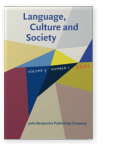Vol. 3:1 (2021) ► pp.34–57
The politics of identity in diasporic media [1] 1
By following a sociolinguistic, ethnographic approach, this paper explores the intricacies behind the construction of a collective identity in the practices of a community radio station, off- and on-air, that serves the Spanish speaking Latin American community in London. The analysis of the information gathered from a 6-months ethnography conducted in a well-established radio station in South London, allowed me to document how the politics of identity delivered on air, far from being a straightforward process, entails some decisions regarding what to say and how, in order to deliver harmonious relations. The shared use of the Spanish language, albeit in different varieties, and some perceived shared values, become the salient markers to present this harmonious identity. Projecting a unified group identity is seen as an important aim for migrants when navigating diaspora in the UK.
Article outline
- 1.Introduction
- 2.Research context
- Latino media in London
- 3.A sociolinguistic ethnographic approach to diasporic media
- 4.Fieldwork and participants
- 5.Analysis
- 5.1Language at the core of the “Latin American community”
- 5.2Professional subjectivities
- 5.3Unity in cultural diversity
- 6.Discussion and conclusion
- Acknowledgements
- Notes
-
References
